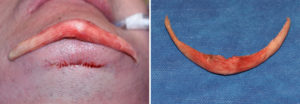Chin augmentation has been one of the most popular facial reshaping procedures for decades. Since its inception in the 1950s, a wide variety of materials have been used for chin implants. Despite this diversity of implanted materials, the silicone chin implant remains the primary implant used due to large number of different styles and sizes, ease of insertion and ease of removal if needed.
One of the chin implant materials used in the late 1990s and early 2000s was that of Goretex, also known as expanded polytetrafluroethylene. Its value as a facial implant material is that it does allow some tissue adherence to develop once implanted. Its microporous surface combined with a fluorine-containing composition allows for tissues to stick to it. This tissue adherence is not as great as Medpor, for example, but is better than that of silicone. Despite these material benefits, it never enjoyed widespread popularity before the product line and the company that made it eventually disappeared into the annals of plastic surgery history.
Every now and then a patient will appear who requests the removal of a Gore-tex chin implant that was placed a long time ago. The request for removal is not usually because it is having any specific medical problems but due a desire to return to their original chin shape before they had the implant placed. This is actually not rare as what one may have wanted at one point in life may change years to decades later.

Dr. Barry Eppley
Indianapolis, Indiana


